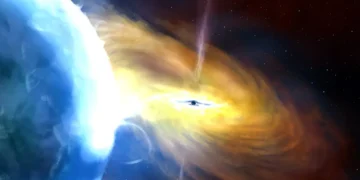Primordial black holes (PBHs), born in the universe’s earliest moments, may be exploding due to Hawking radiation—a process that slowly evaporates black holes. These cosmic fireworks could unlock new physics, revealing the nature of dark matter and rewriting our understanding of the universe.
The Origins of Primordial Black Holes
PBHs are not your typical black holes. Unlike those formed from the collapse of massive stars, PBHs are thought to have originated during the first fractions of a second after the Big Bang. In this primordial era, tiny regions of space experienced extreme density fluctuations. These pockets of concentrated energy collapsed under their own gravity, creating PBHs. What makes PBHs extraordinary is their potential range of sizes. Some could be as small as a grain of sand, while others might rival a large asteroid. This diversity sets them apart from conventional black holes and makes them fascinating candidates for solving long-standing cosmic riddles.
Hawking Radiation: The Black Hole’s Slow Burn
In the 1970s, physicist Stephen Hawking proposed a revolutionary idea: black holes are not completely “black.” Instead, they emit radiation due to quantum effects near their event horizons. This phenomenon, now known as Hawking radiation, occurs when virtual particle-antiparticle pairs appear near a black hole. Normally, these pairs annihilate each other almost instantly, but if one particle falls into the black hole, the other escapes as radiation. This process causes the black hole to lose mass over time. For large black holes, this “evaporation” is negligible, but for smaller ones like PBHs, Hawking radiation becomes a dominant force. As PBHs emit radiation, they heat up, accelerating the evaporation process. Eventually, they are predicted to explode in a spectacular burst of energy.
The Explosive Evidence of PBHs
Detecting a PBH explosion is one of the most thrilling prospects in modern astrophysics. These cosmic fireworks would release high-energy particles, including gamma rays, neutrinos, and potentially unknown particles. Scientists believe that observing such an event could confirm the existence of PBHs and provide direct evidence of Hawking radiation. Physicists like Marco Calzà and João G. Rosa have developed advanced tools to study PBHs during their final stages of evaporation. By analyzing the properties of their radiation, researchers can estimate a PBH’s mass, spin, and even its history. This approach offers a unique opportunity to test the limits of our current understanding of physics.
A New Window into Dark Matter
One of the most tantalizing questions in science is the nature of dark matter—the invisible substance that makes up 85% of the universe’s mass. PBHs have emerged as a potential answer to this mystery. If they are abundant enough, their collective gravitational pull could account for the missing mass. The connection between PBHs and dark matter lies in their elusive nature. Unlike stars and galaxies, which emit light, PBHs could exist undetected, scattered throughout the universe. Observing their Hawking radiation could reveal their distribution and provide crucial insights into their role as dark matter candidates.
The Challenges of Detection
Despite their theoretical significance, PBHs have remained elusive. Detecting a PBH explosion requires instruments capable of capturing high-energy bursts over vast distances. Current gamma-ray and neutrino telescopes, such as NASA’s Fermi Gamma-ray Space Telescope and the IceCube Neutrino Observatory, are at the forefront of this search. Upcoming telescopes with enhanced sensitivity offer even greater promise. By combining data from multiple observatories, scientists hope to identify the unique signatures of PBH explosions. This collaborative effort represents the cutting edge of astrophysical research.
What PBHs Can Teach Us About the Universe
The study of PBHs is not just about solving one mystery—it’s about rewriting the rules of physics. These black holes act as natural laboratories for testing theories that go beyond the Standard Model of particle physics. For instance, their radiation could reveal the existence of axions, hypothetical particles predicted by string theory. Furthermore, the behavior of PBHs during evaporation could provide insights into quantum gravity, a field that seeks to unify General Relativity with quantum mechanics. By tracking the evolution of a PBH’s mass and spin, scientists can probe the fundamental forces shaping the universe.
Implications for Cosmology
The implications of PBH research extend far beyond astrophysics. If PBHs are confirmed as dark matter, it would resolve one of the greatest puzzles in science. Even if PBHs are not the primary source of dark matter, their study could inspire innovative approaches to other cosmological questions. For instance, understanding the mechanisms of Hawking radiation might lead to breakthroughs in fields ranging from quantum mechanics to particle physics.
Conclusion
Primordial black holes represent a tantalizing frontier in science, bridging the gap between the early universe and modern physics. From their potential role in dark matter to their connection with Hawking radiation, PBHs offer a wealth of opportunities for discovery. Observing a PBH explosion could be a game-changer, providing direct evidence of phenomena that challenge our current understanding.
Reference:



















